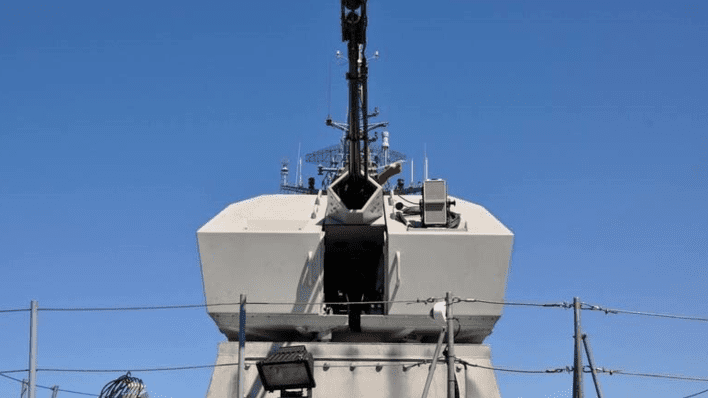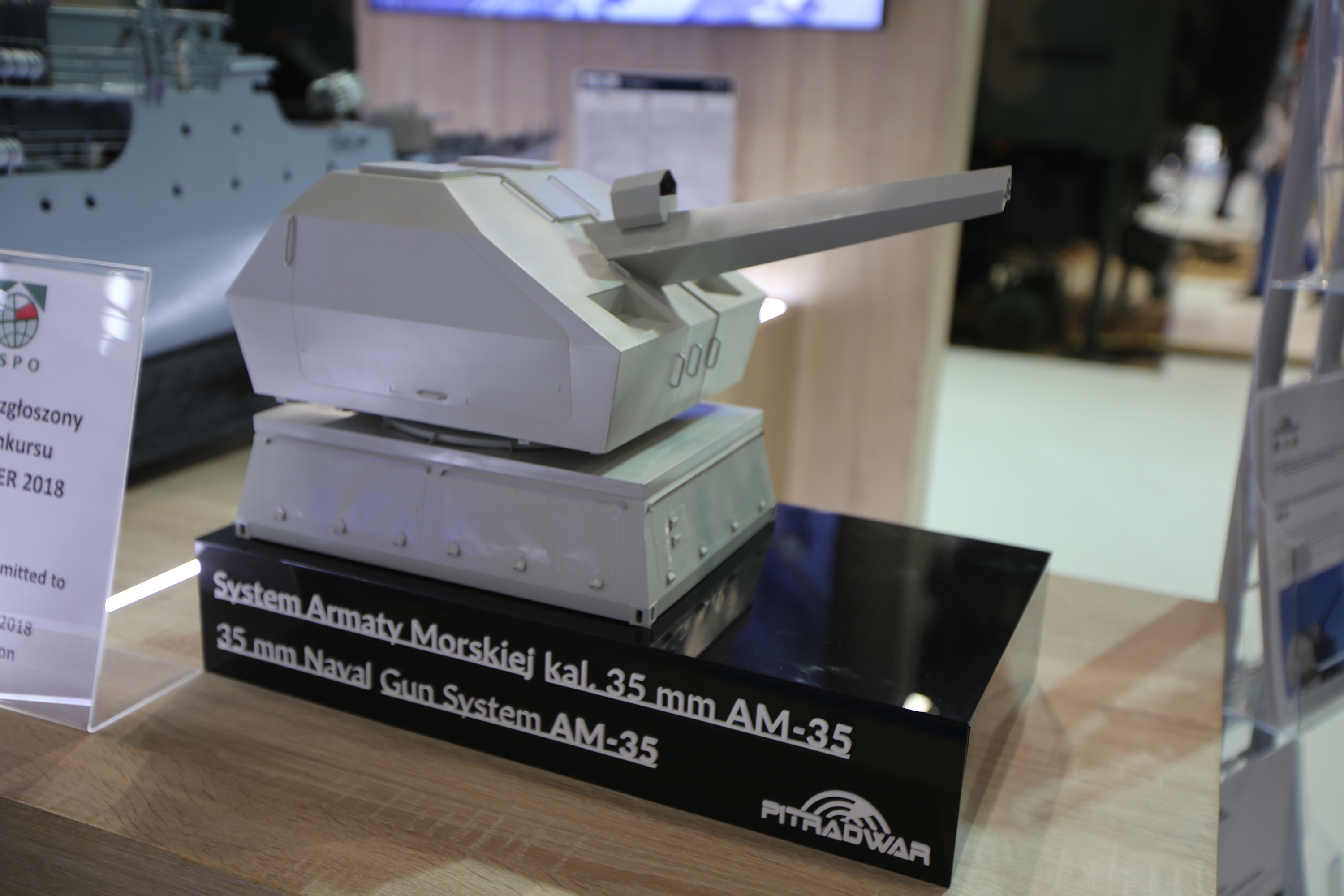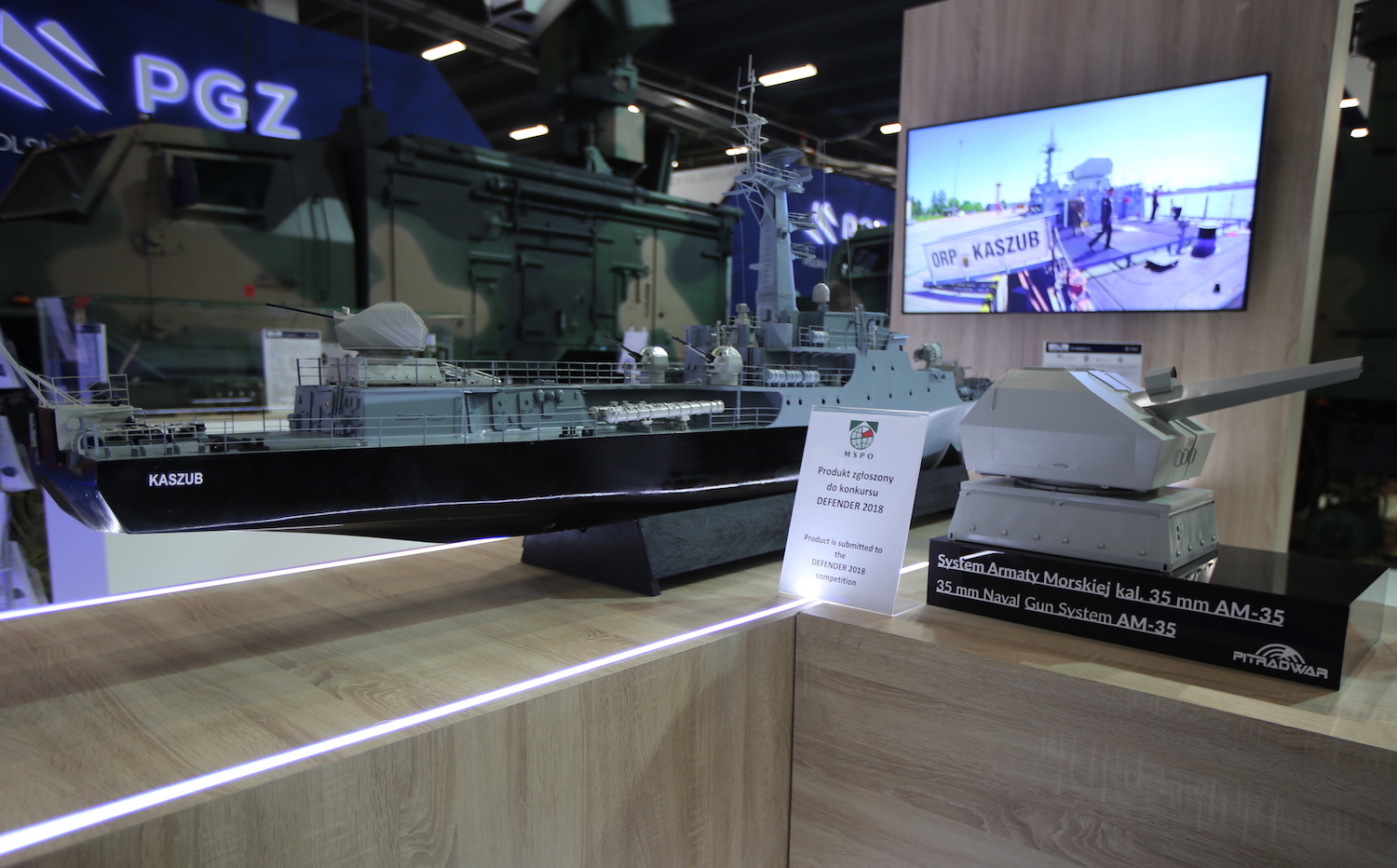35 mm OSU (Vessel Armament System) Certified

Acquisition of new short range artillery systems has been, for many years, an unaccomplished task among the modernization requirements the Polish Navy has. This gap, identified by the MoD back in the 1990s, is going to be filled in soon enough by the automatic 35 mm vessel cannon system that has been developed by a Polish industrial-research consortium involving the Military University of Technology and Polish Naval Academy, as well as PIT-RADWAR S.A. and ZM Tarnów companies. Following the recent tests on naval firing ranges, including test firing, the qualification of the equipment came to an end by issuing a state armament certificate. And this also has been the last stage of this project.
“What we have managed to achieve within the framework of this project is an artillery system made in Poland in its entirety which, after being installed on ORP Kaszub, went through a test programme and has consequently been classified by the state as a weapon” - said Sławomir Łuszczak, MSc, working for the PIT-RADWAR S.A. company that acts as the main integrator and technical contractor developing the OSU 35 artillery system.
The quote above covers the successful completion of tests onboard the ORP Kaszub vessel. On the other hand, it also refers to the positive results of the recent test firing (25th July 2018), directly preceding the formal armament qualification stage (permitting the product to be offered in defence procurement procedures). The above also means that final verification of the product usability is going to take place now, following the operational sea trials. According to the expectations of the company representatives, this goal is going to be accomplished within 1-2 upcoming years.
Ultimately OSU 35 is being developed for the modern Kormoran II class MCMVs. Earlier on some suggestions have been made that the system may be installed on other vessels, both those newly built, as well as those that are already in operation and that are expected to be modernized.
Various options of adapting and configuring the OSU 35 system are a result of its open architecture, modularity and scalability, allowing for free integration on various classes of vessels. Introduction of a simplified and rapid method for fixing/disassembling the cannon has been an innovative solution here. It only takes around 10 minutes to carry out this process. This means that the cannon base features 4 container-type connectors fixed, in 8 points, to the ship. In case of ORP Kaszub, they have been prepared in cooperation with the Remontowa Shipbuilding S.A. shipyard based in Gdansk.
In case of ORP Kaszub, a principle has been adopted to minimize the hull structure modifications. There was no need to place the turret body inside the vessel, it turned out it is enough to place a power supply system and wiring under the deck. Meanwhile, the plans to arm the Kormoran-class vessels, with the deck prepped for setting up the cannon at the building stage, assume that the cannon would be integrated within the vessel’s hull.

As the research and development potential grew, during the project implementation, numerous previously unused, new design solutions were implemented. Above all, the gun is going to be controlled from the ship’s CIC, with the use of operator’s panel. The targeting, tracking and observation functions will be ensured by a stabilized optronic system and a fire control system. OSU 35 is the first system of this kind with a domestically made cannon that does not involve the gun crew actually manning the gun. All of the targeting and operational activities are carried out via the operator’s panel, within the primary fire control station or within the reserve fire control station.
OSU 35’s parameters, recently confirmed during the qualification tests, pertain to laying down fire at a horizontal range of 5.5 kilometres and up to an altitude of 3.5 kilometres (depending on the ammunition utilized), with a rate of fire of 550 rounds per minute. Each of the two ammunition storage spaces can contain up to 100 rounds of ammo. The naval gun is to be as effective against air threats, as it is against naval or coastal threats. KDA automatic cannon is controlled via the electrohydraulic control system controlled by the UKiSA block (System for Control and Steering of the Automatic Gun, designed and supplied by ZM Tarnów).
Read More: MSPO 2018: Poland and its Radar Technologies
The OSU 35 development stage achieved now is a result of experience gathered during the development of the “Loara” AAA system, that has been in development at PIT-RADWAR S.A. since the mid-1990s. The system was based on a licence procured to manufacture the KDA gun back in 1995. Let us recall that a single example of implementation lot was manufactured back then, with the project ceased by a decision made by the MoD back in 2009. Rights to the Oerlikon Contraver KDA 35 mm automatic cannon were the subject of the licensing agreement (with that company being active since January 2009, within the framework of the Rheinmetall consortium as Rheinmetall Air Defence). The technological benchmark here involved the KDA cannon with the barrel.
The experience gathered allowed PIT-RADWAR S.A to expand its armament manufacturing model that was to address the needs of both the Navy, the Army, as well as those of the potential export customers. The acquired license made it possible for the brand to manufacture the anti-aircraft system in Poland. The manufacturing was outsourced, within the framework of an implementation agreement, to the HSW S.A. company. Development of a complete vessel-based solution was taking place within the framework of an R&D initiative supported by the National Centre For Research and Development. The implementation was dealt with by a consortium involving the Military University of Technology, Polish Naval Academy in Gdynia and PIT-RADWAR S.A and ZM Tarnów companies.
The naval variant of the system is based around a number of subsystems, including drive, power supply, ammunition feed (two independent supplies) and a stabilizer unit. Externally the OSU system is complemented by an integrated ZGS-158M tracking unit. The optronic sensor in question has a thermal imaging camera (3-5 μm) and TV camera integrated, along with a HF laser rangefinder (more than 10 Hz - which makes it possible to act against fast moving targets). The optronic sensor is also integrated with a short range IFF IKZ-02U interrogator manufactured by PIT-RADWAR S.A. Should a need emerge, the cannon may also be fired manually, with the use of the reserve fire control station.

The armament system on the vessel, in order to achieve automation to a full degree, needs extra radar sensors to be fitted alongside: early detection radar and a tracking radar. These elements are not placed within the scope of the project. PIT-RADWAR S.A. suggests that they have a key relevance, when it comes to further development of the OSU solution, with regards to enhancing the capacity system would offer in acting against maneuvering threats.
At the moment talks are in progress, on development of radar sensors for the Polish Navy, that could be placed within the warship’s combat system.
One of the important domains in works on the OSU 35 solution was seen in development and use of the stabilizer making it possible to lay down effective fire in sea conditions, from a moving vessel. This pertains both to the line-of-sight compensation, as well as the stabilized view in case of the integrated optronic tracking unit.
Developing a stabilizing system for a naval gun (with its size and dynamics taken into account) has only been possible thanks to the fact that a dynamic test station has been created at PIT-RADWAR S.A., with unprecedented specification. The station has been created on the basis of Stewart’s platform with 6 degrees of freedom, making it possible to move objects weighing up to 12 tonnes.
As a result of the above, the first ever stabilized naval artillery system has been created, with working with any vessel and external targeting systems in mind. The tracking and stabilizing systems of the cannon (horizontal and vertical), feature two brushless electric motors each. High dynamics and precision of movement have been assured and provided thanks to use of modern solutions derived from the energy industry. For instance, super-capacitors have been used to create the energy buffers. The stabilizer design developed by PIT-RADWAR S.A. has turned out to be effective in test firings and during the vessel tests in a variety of conditions at sea, passing the final qualification test programme. The experiences gathered within that scope can be used in creating a land-based artillery system using the KDA automatic cannon.
Programmable ammunition is being developed by a separate consortium, with the new gun in mind, making it possible to detonate the projectile at a given point in space (at time programmed starting from the moment when the projectile leaves the barrel). Thanks to philosophy as such the artillery round gets a greater chance of hitting the target (including small-sized targets such as aircraft and light vehicles). The naval gun with a double belt feed also has an ability to effectively switch between the types of ammunition, or to lay down alternate fire, depending on the emerging circumstances. Double feed makes it possible to immediately use programmable and sabot rounds, which greatly enhances the system’s effectiveness.
The whole system also includes a replaceable air-cooled barrel. Furthermore, the AM-35 gun has its own inertial navigation and spatial orientation systems at its disposal.
The armament system in question has also been tested within the scope of acting against small-sized targets. Among four light Shogun MJ7 UAVs acting as the targets, all have been hit with the rounds fired.
The 35 mm gun system is offered to the Polish Navy as an asset designed to act against non-armoured and lightly armoured naval vessels and land targets. It is also destined to be used against aircraft, helicopters, UAVs, missiles and bombs. It is expected that the AM-35 gun is fitted onto the second and the third vessels of the Kormoran II class. The test example fitted on the ORP “Kaszub” is still going to be used on that vessel. Introduction of the gun into service is still dependent on the future assumptions made by the MoD.
Notably, the Administrator (Navy Inspectorate) was getting involved in the gun development process at every stage of the project. The Inspectorate, together with the designers, was resolving doubts emerging along the way, supporting the user and using the knowledge derived from service. The joint activities undertaken by the Administrator and by the Consortium resulted in development of a product that is ready to face the contemporary naval threats. The results of this cooperation have been appreciated, as the system has received the Defender award, during this year’s edition of the MSPO International Defence Industry Exhibition held in Kielce.